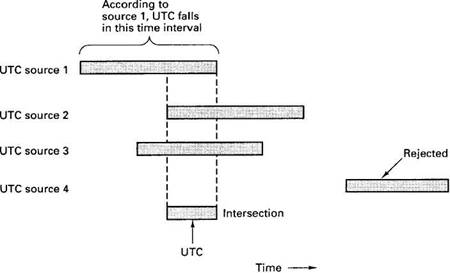Книга: Distributed operating systems
10.4.2. DTS Implementation
10.4.2. DTS Implementation
The DTS service consists (conceptually) of several components. The time clerk is a daemon process that runs on client machines and keeps the local clock synchronized with the remote clocks. The clerk also keeps track of the linearly growing uncertainty of the local clock. For example, a clock with a relative error of one part in a million might gain or lose as much as 3.6 msec per hour, as discussed above. When the time clerk calculates that the possible error has passed the bound of what is allowed, it resynchronizes.
A time clerk resynchronizes by contacting all the time servers on its LAN. These are daemons whose job it is to keep the time consistent and accurate within known bounds. For example, in Fig. 10-17 a time clerk has asked for and received the time from four time servers. Each one provides an interval in which it believes that UTC falls. The clerk computes its new value of time as follows. First, values that do not overlap with any over values (such as source 4) are discarded as being untrustworthy. Then the largest intersection falling within the remaining intervals is computed. The clerk then sets its value of UTC to the midpoint of this interval.
After resynchronizing, a clerk has a new UTC that is usually either ahead or behind its current one. It could just set the clock to the new value, but generally doing so is unwise. First of all, this might require setting the clock backward, which means that files created after the resynchronization might appear to be older than files created just before it. Programs such as make will behave incorrectly under these circumstances.

Fig. 10-17. Computation of the new UTC from four time sources.
Even if the clock has to be set forward, it is better not to do it abruptly because some programs display information and then give the user a certain number of seconds to react. Having this interval sharply reduced could, for example, cause an automated test system to display a question on the screen for a student, and then immediately time out, telling the student that he had taken too long to answer it.
Consequently, DTS can make the correction gradually. For example, if the clock is 5 sec behind, instead of adding 10 msec to it 100 times a second, 11 msec could be added at each tick for the next 50 seconds.
Time servers come in two varieties, local and global. The local ones participate in timekeeping within their cells. The global ones keep local time servers in different cells synchronized. The time servers communicate among themselves periodically to keep their clocks consistent. They also use the algorithm of Fig. 10-17 for choosing the new UTC.
Although it is not required, best results are obtained if one or more global servers are directly connected to a UTC source via a satellite, radio, or telephone connection. DTS defines a special interface, the time provider interface, which defines how DTS acquires and distributes UTC from external sources.
- Implementation ID
- 3.4.3. Implementation
- 11.5.2 Implementation Considerations
- 2.4.5. Implementation Issues
- 4.3.3. Implementation Issues for Processor Allocation Algorithms
- 5.2. DISTRIBUTED FILE SYSTEM IMPLEMENTATION
- 9.5.3. Implementation of UNIX on Chorus
- 9.6.5. Implementation of COOL
- 10.4.1. DTS Time Model
- Overriding Interface Implementations
- Implementation Inheritance
- Explicit Interface Members Implementation




